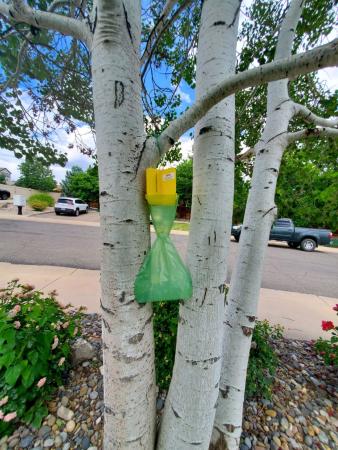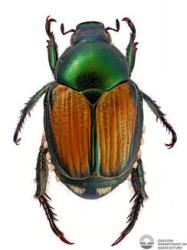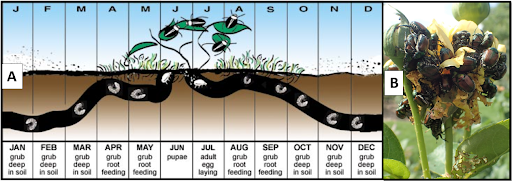In the summer of 2022, when the first Japanese beetles were spotted in a Grand Junction backyard, the invasive species had not been seen in the area for more than a decade. After successful eradication efforts between 2002-2007, the pest was removed from the Western Slope, where it posed a threat to agriculture and the economy. But it reappeared again in 2022, likely due to transport by an unlicensed landscape contractor who violated the Japanese beetle quarantine from Front Range counties.
Since then, the Department of Agriculture has been working with the City of Grand Junction, Mesa County’s Noxious Weed and Pest Management, and the CSU Tri-River Extension office set up traps that monitor the presence of the pest across the affected area and work to eradicate the pest once more.
Western Slope residents who suspect they have Japanese beetles should immediately notify their local pest control district or CSU Extension office. Those in Mesa County should contact the Tri-River Extension Office at 970-244-1834.
For Front Range residents, CDA strongly recommends that no nursery stock of any kind, including sod or flowering plants, be moved to any other part of Colorado where Japanese beetles have not been detected, including the West Slope. Additionally, before undertaking any landscape project, homeowners should consult their chosen landscape contractor to make sure they are registered with CDA and where they are getting the plant material or sod.
Meanwhile, Mesa County officials continue to work with local homeowners to eradicate the pest.
“Property owners in the affected areas of Mesa County understand the importance of eradicating this invasive and destructive pest early, and Mesa County secured nearly unanimous consent from homeowners and Homeowners Associations to treat lawns for beetle grubs in those impacted neighborhoods,” said Melissa Schreiner, entomologist with the Colorado State University Tri-River Extension Office. “It’s important to protect the Grand Valley from this voracious pest that feeds on leaves, flowers, fruit, shrubs, perennials, and turf grass. Anyone suspecting the presence of the Japanese beetle should contact their local CSU Extension for more information.”
CDA has been supporting the efforts of community members to stop the pest.
“We have been working in partnership with a great local team on setting traps to measure the spread of the Japanese beetle in the affected area of Mesa County. Our plan is to treat turf before the grubs emerge and continue to trap and monitor numbers of Japanese beetles in the area to determine the best approach and efficacy of treatments,” said Cheryl Smith, Program Manager in the Division of Plant Industry.
The first round of ground treatments (using Acelepryn) started in mid-May and will conclude by the end of June. Mesa County is estimating that 95% of those in the eradication zone have agreed to the treatment, which means no additional enforcement will be necessary, though there is a possibility of a second treatment this fall. Traps were set beginning on May 16, 2023 and approximately 400 traps will be in place by the end of June. Local and state pest managers will continue to monitor the traps all summer and reevaluate this fall for next year's eradication plan and area.
The Japanese beetle is a threat to agriculture and ornamental horticulture on the Western Slope. The pests feed on more than 300 species of plants, many of which are essential to western Colorado’s agricultural economy, including peaches, grapes, sweet corn, turf, and many other ornamental plants in urban spaces, including turf grass.
The presence of this invasive beetle is already harming the Western Slope's green industry. Some exports of plants out of Mesa County to areas without Japanese beetle (like the State of New Mexico) have been denied by other states.
The Western Slope successfully staved off the beetle in the past. In 2002, a Master Gardener discovered the pest in the Grand Valley. The Upper Grand Valley Pest Control District (UGVPCD) acted decisively to eradicate the pest and reduced its population by 99% over five years. The hope is to do the same this time around.
Anyone living in Mesa County who suspects they have Japanese beetles present on their property should contact the CSU Tri-River Extension office with any questions or for help identifying and eliminating the insect. For more information on the Japanese beetle and other pests, please visit ag.colorado.gov/plants/pest-survey.
More about the Japanese beetle
What do beetles look like?
The Japanese beetle is a scarab beetle, approximately 1/3 to 1/2 inch long with a metallic green body
and copper-colored covers on its wings. Close examination with a hand lens will reveal 12 tufts of white hairs bordering the margin of the wing covers. The beetles tend to be found in groups, so if you see one there likely are several more.
Larvae, or grubs, reside in the soil. They are about an inch long when fully grown and lie in a curled or “C” shaped position. Close examination of the grubs will reveal a V-shaped series of bristles on the tip of the abdomen.
What damage do Japanese beetles cause?
Japanese beetles are a highly destructive plant pest that can be very difficult and expensive to control. Feeding on grass roots, Japanese beetle grubs damage lawns and pastures.
Adult Japanese beetles attack the foliage, flowers, or fruits of more than 300 different ornamental and agricultural plants, including those vital to Colorado agriculture like peaches, grapes, sweet corn, and more.
How to control the insect?
A simple solution of dish soap and water can suffocate the insects. You can either spray your plants with the solution (a teaspoon of dish soap per quart of water) or pick or shake the beetles into a bucket of soapy water. Anyone on the Western Slope who suspects they have Japanese beetles should contact the CSU Tri-River Extension office.




